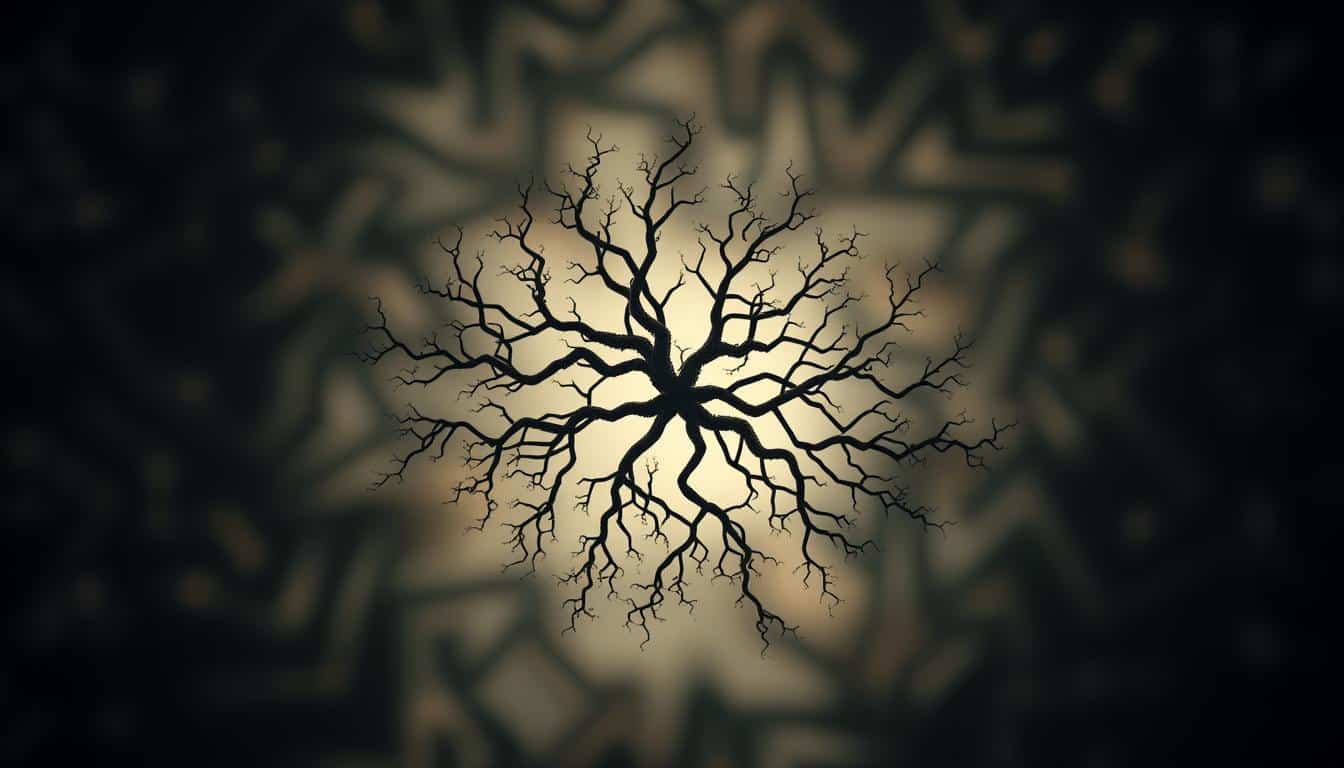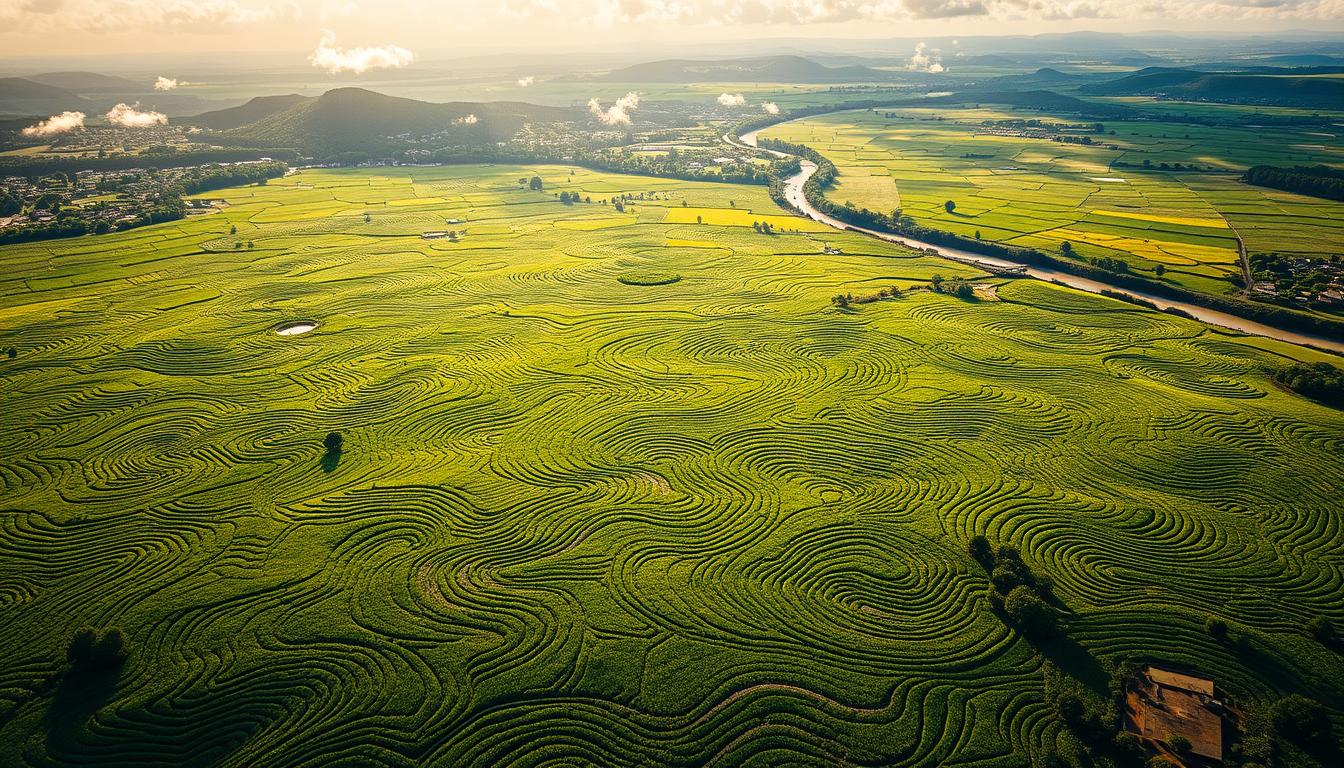Fractals are complex patterns that look similar at every scale. This piece introduces the math behind fractals. It shows why they matter in art and chaos theory.
These intricate shapes show how nature works in dynamic ways. They reveal the world’s complexity through beautiful, repeating patterns.
Introduction to Fractals
Fractals open the door to the exciting world of math exploration. They are intricate structures that are similar at different scales. This similarity in patterns is what fractal theory is all about. It connects complex math with the natural world around us.
Fractals are everywhere, showing us the beauty of math in nature. You can see them in coastlines, mountain ranges, and the way trees branch out. These patterns, big or small, follow fractal rules. They show us how nature’s designs are guided by math.

What Are Fractals? Mathematical Foundations for Beginners
Fractals show us complex patterns, going beyond regular shapes. They unfold complexity with each repetition and resemble themselves in different sizes. This makes them interesting in various fields.
Definition of Fractals
Fractals are patterns that go on forever, showing endless complexity. They get their name from “fractus,” the Latin word for “broken,” highlighting their feature of self-similarity at multiple scales. You can find these patterns in nature, from small beach shells to huge galaxies. Fractals are made by repeating simple steps, creating breathtaking designs that blend math and art.
Characteristics of Fractals
Fractals have distinct characteristics that make them unique. Important features include:
- Recursive generation through repeated applications of a specific process.
- Self-similar patterns that are recognizable at various scales.
- Presence in both natural environments and abstract mathematical forms.
These features make fractals both mesmerizing and complex. They help us understand the mathematical patterns in our world.
The Importance of Self-Similarity
Self-similarity is key in studying fractals. It shows how patterns repeat at various sizes in nature. You can see this in many places, showing how things in nature are connected.
Understanding Self-Similarity in Nature
When we look at self-similarity, we see it everywhere around us. Take trees, for instance. Their branches make smaller copies of themselves. Rivers, too, make similar shapes as they travel through the land. These patterns show us nature’s math.
Examples of Self-Similar Patterns
Many natural patterns are great examples of self-similarity:
- Ferns grow fronds that look like mini versions of the whole plant.
- Broccoli shapes itself into a fractal, with each piece reflecting the whole.
- Coastlines change scale but keep their shape, from big views to small ones.
These patterns show the deep and beautiful complexity of nature. By looking at them, we learn about how our world has formed over time.
Fractals in Nature
Fractals show amazing patterns in nature, revealing the complexity around us. We see these patterns in places like trees, coastlines, and seashells. They show the detailed designs made by life and earth’s processes.
Natural Examples: Trees and Coastlines
Trees are perfect examples of fractals in nature. Their branches look similar, just in smaller forms. Coastlines also show fractal shapes with their uneven edges. These edges look the same at different sizes. Trees and coastlines help us see how fractals work in natural settings.
Unique Patterns Found in Nature
Fractals aren’t just in trees and coastlines. We find them in leaves, seashells, and clouds too. These patterns are not just beautiful. They tell us about how things evolve and the health of ecosystems. Each pattern is part of a bigger story about life on Earth.
The Role of Recursion in Fractals
Recursion is key to making fractal patterns. It uses a simple step over and over to make complex images. These images show the beauty of nature and math. Such repetition gives fractals their unique symmetry.
How Recursion Creates Complex Patterns
Recursion can make detailed designs with loops. Each loop adds more detail, building up the fractal patterns. This makes for eye-catching shapes that show complexity can come from simple rules.
Feedback Loops in Fractal Generation
Feedback loops are crucial in fractals. Even small changes can greatly alter the final image. This creates unexpected patterns in fractal math. Such loops show how tiny tweaks can make big differences, leading to beautiful fractal designs.
The Mathematics Behind Fractals
Fractal mathematics lets us see complex shapes that don’t follow normal geometry. It teaches key ideas for understanding patterns in fractals. By looking at these patterns, we see the deep beauty in famous fractals.
Basic Mathematical Concepts
Fractal math is about recursive functions and non-integer dimensions, or fractal dimensions. These ideas help create shapes that look detailed up close or far away. Fractals are made from simple processes that repeat, making new patterns.
Famous Mathematical Fractals
The Mandelbrot set and the Julia set are well-loved examples of fractals. The Mandelbrot set shows a world of color and shape from simple math, fascinating both mathematicians and artists. The Julia set adds its own special beauty, showing the complexity of fractal geometry.
Exploring the Mandelbrot Set
The Mandelbrot set is famous for being a complex and beautiful fractal. It amazes both mathematicians and artists. Its deep math and infinite patterns draw people into the world of fractals.
Introduction to the Mandelbrot Set
The Mandelbrot set starts with a simple equation. Yet, it shows countless detailed shapes as you zoom in. It opens the door to understanding complex math concepts through its captivating patterns. Every step deeper shows more beauty in math.
Interactive Exploration Techniques
There are many ways to explore the Mandelbrot set, but interactive fractals are special. They let people dive into its depths in real-time. Tools like fractal zoomers make it easy to see and enjoy the repeating patterns. These experiences help people learn the math behind it all while having fun.
Fractals and Chaos Theory
Chaos theory digs into how unpredictable dynamic systems can be. It shows us how small changes can lead to big differences. This idea changes how we see complex systems. It also connects different phenomena together. Chaos theory helps us find patterns in what seems random.
Fractals are pictures of chaos, showing complex patterns from simple rules. These patterns reveal how small tweaks can change outcomes a lot. By linking chaos and fractals, experts can model nature. This helps them understand complex systems better. It’s crucial in many study areas.
The Butterfly Effect
The butterfly effect is a fascinating idea. It shows how small changes can have big impacts. This idea comes from chaos theory. It’s about the connections that control our world.
It applies to many areas, like weather forecasting or the economy. Understanding these connections can help us see how unpredictable things can be.
Understanding the Concept
The idea is simple: a butterfly flapping its wings might cause a hurricane far away. This shows how sensitive systems are to small changes. Tiny actions can lead to big effects.
Impact of Minor Changes in Complex Systems
These small changes question predictability in chaos theory. Complex systems often act in unexpected ways. The way parts are connected means small differences can change outcomes significantly.
This is clear in economics. Even slight changes in how people feel can affect the whole market.
Applications of Fractals in Different Fields
Fractals are used in many areas, bringing new benefits and ideas. They help improve technology and make us understand nature better.
Fractals in Medicine and Biology
Fractal analysis is key in medical fields. It’s used in medical imaging to understand body structures better. For example, looking at blood vessels or lung patterns with fractal geometry helps doctors diagnose illnesses better. This approach helps model complex biological shapes, improving how patients are cared for.
Fractals in Engineering and Architecture
In engineering, fractals lead to creative and efficient designs. They help engineers make designs that save resources and are sustainable. Architecture uses fractal patterns too, making buildings that look good and fit well with nature. This shows how designs can combine human creativity with natural patterns.
Creating Fractals Using Computers
Exploring digital fractals means using complex algorithms to create beautiful visuals from mathematical functions. This turns deep math into stunning, vibrant images. It shows how fractals can be beautiful through digital creation.
Digital Fractal Generation Techniques
There are several ways to make digital fractals, including:
- Iterative algorithms that repeatedly apply calculations to create detailed designs
- Recursive functions that allow for the generation of self-similar patterns
- Randomization to introduce unique variations in fractal patterns
This blend of art and math results in amazing computer-made fractals. Both artists and mathematicians love them.
Popular Software for Exploring Fractals
There are many fractal software choices. These cater to various skill levels and interests:
- Ultra Fractal – It’s versatile, letting users create layered fractals with lots of custom options.
- Mandelbulb 3D – This focuses on 3D fractals, opening new creative options.
- Apophysis – A free tool great for beginners interested in making flame fractals.
Thanks to accessible fractal software, people can dive into the world of computer-made fractals. They can be both creative and explore mathematics.
The Aesthetic Appeal of Fractals
The visual allure of fractals captivates artists and audiences alike. This mathematical beauty translates into stunning artwork. It showcases complex patterns that challenge conventional ideas of beauty.
Fractal art highlights the intricate designs found in nature. It serves as a profound intersection of art and science. This enriches our understanding through its aesthetic appeal.
Beauty in Complexity: Fractals in Art
Fractal art invites viewers to engage deeply with the imagery. It is created from mathematical principles. Artists utilize these principles to make pieces that are mesmerizing and thought-provoking.
Through shaping and colors, fractal art shows the balance between chaos and order. It inspires a sense of wonder and curiosity.
Fractal Art and Its Cultural Impact
The cultural significance of fractal art is huge. It merges intricate scientific concepts with creative expression. This fosters a unique dialogue between disciplines.
This connection encourages exploration beyond traditional art forms. It resonates with a broader audience. Fractal art sparks interest in mathematics and promotes artistic innovation. It embodies the unity of knowledge and creativity.
Conclusion
Fractals show their importance across many fields, like math and the natural sciences. They let us see the complex patterns in the universe. They also show how order and chaos are connected. This talks about how fractals reflect complex systems. They reveal rules that control nature and abstract ideas.
We learn to see the beauty in nature through fractals. This includes the way trees branch out and the shapes of coastlines. Studying these patterns helps us understand how simple things become complex. It shows through processes like repeating and self-similarity. This knowledge makes us value our world more.
The study of fractals makes us curious beyond just one subject. They help in art, science, and engineering. Their use leads to new ideas and creativity. Learning about fractals helps us understand and appreciate the complexities of life.



